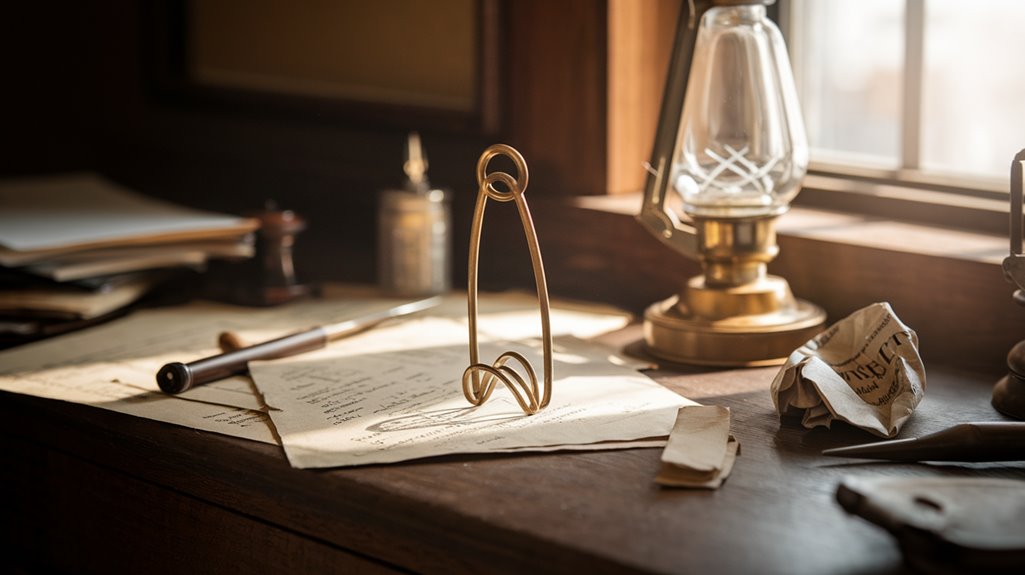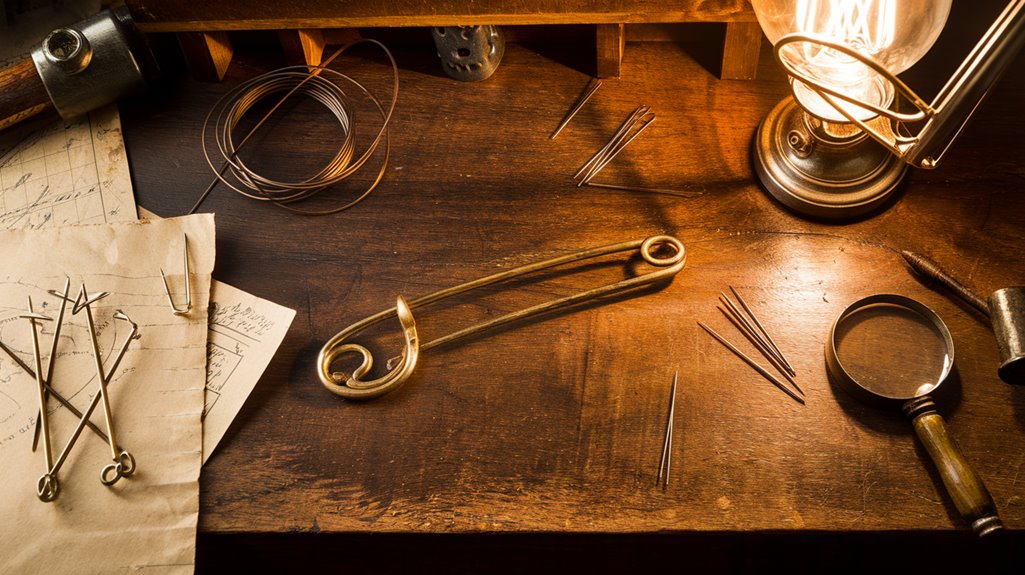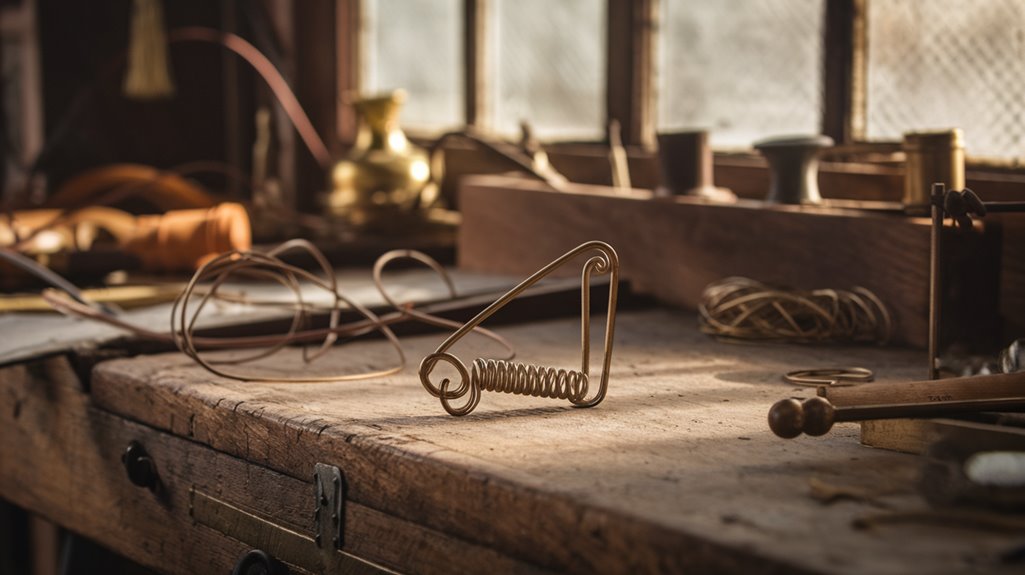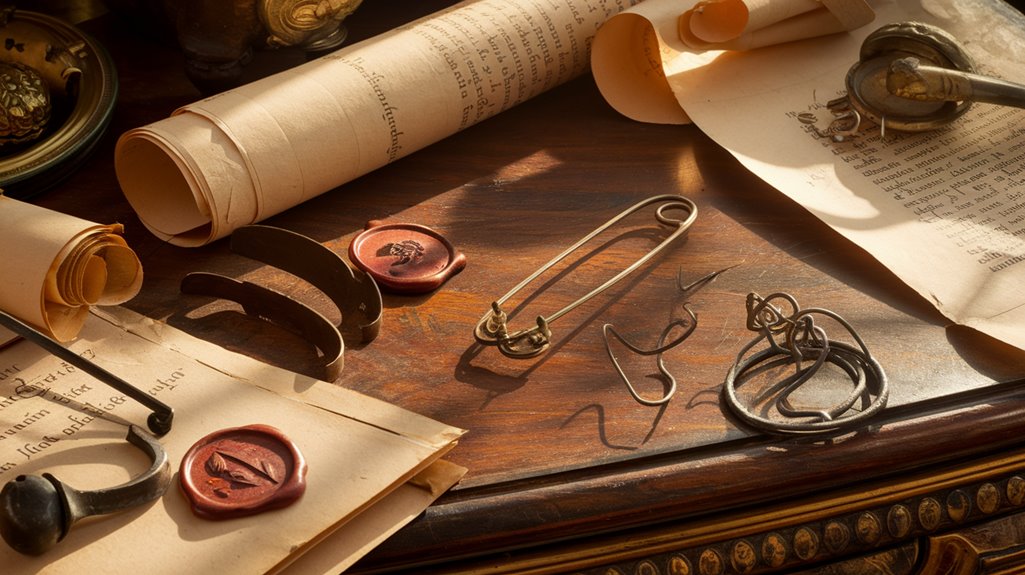Walter Hunt’s Absentminded Pin Twiddle That Created the Safety Pin
You've likely used a safety pin without giving it a second thought, but this humble invention has quite a story behind it. In 1849, Walter Hunt found himself fidgeting with a piece of wire while pondering how to pay off a $15 debt. His nervous habit turned into an unexpected stroke of genius that would change fashion and functionality forever. What happened next would prove both fortunate and tragically shortsighted for the inventor.
The $15 Debt That Sparked Genius

While many great inventions emerge from years of careful planning, the safety pin sprang from a simple $15 debt in 1849. You might be surprised to learn that this debt motivation pushed Walter Hunt to create one of history's most practical devices.
When a draftsman demanded payment, Hunt's financial innovation emerged from pure necessity. The desperate inventor was given twenty centimeters of wire to create something worthwhile. Facing mounting stress over this seemingly small sum, Hunt began fidgeting with a piece of wire in his workshop. His experimentation led to a breakthrough: a pin with a spring mechanism that wouldn't prick its user. As a trained mechanical engineer, Hunt had the skills to transform his wire experiments into a practical design.
Hunt quickly sold the patent to W R Grace and Company for $400, far more than needed to clear his debt. Though the sale provided immediate relief, you'll find it ironic that his rushed solution to a minor debt would generate fortunes for others.
From Wire Twist to Revolutionary Design
When Hunt started twisting that piece of wire in his workshop, he couldn't have known he'd create one of history's most elegant solutions. Through careful wire manipulation, he discovered that creating a circular twist at the bend would provide the perfect spring tension needed to secure the pin in place. Like many of his other inventions including shirt collars and bullets, Hunt was more focused on creating than commercializing his innovations.
You can see the brilliance in his design evolution: the coiled wire formed a secure clasp that protected the pointed end, while the spring mechanism kept everything firmly in position. Sadly, Hunt only received $400 for the rights to his revolutionary invention, missing out on the fortune it would later generate.
What made his creation revolutionary wasn't just its simplicity – it was the protective covering that prevented accidental pricks and keeps the pin securely fastened. This fundamental design has proven so effective that it's remained virtually unchanged since its patent in 1849, demonstrating how sometimes the simplest solutions are the most enduring.
Ancient Rome's Surprising Connection
Long before Walter Hunt's workshop breakthrough, ancient Romans had already mastered a remarkably similar technology.
While you might think the safety pin was a modern innovation, Romans used fibulae – sophisticated bronze brooches that shared striking similarities with today's safety pins.
These devices weren't just practical fasteners in Roman fashion; they carried deep Fibulae symbolism that revealed the wearer's identity.
Here's what made fibulae so significant:
- They displayed marital status and social rank within Roman society
- Different designs identified specific professions and military positions
- The spring mechanism matched modern safety pin engineering
- They spread throughout Europe as both functional tools and decorative jewelry
This ancient technology laid the groundwork for Hunt's later invention, proving that brilliant ideas often have deep historical roots. These early Roman pins were often adorned with jewels to signify wealth and status. When Hunt finally created his version in 1849, he made a mere four hundred dollars from selling the patent.
The $400 Patent Sale and Lost Fortune
The safety pin's journey from ancient Rome to modern times takes an ironic turn with Walter Hunt's fateful decision in 1849.
You'd be amazed to learn that Hunt sold his safety pin patent for just $400 (about $14,650 today) to W R Grace and Company to settle a mere $15 debt to his draftsman, J.R. Chapin.
The patent valuation proved catastrophically low, as W R Grace went on to make millions from Hunt's invention.
While you're likely familiar with the safety pin's enduring design in everything from diapers to clothing, Hunt never saw a penny beyond that initial sale.
His financial regrets mounted as he watched his creation become a worldwide success without earning any royalties.
The simple transaction that cleared a small debt ultimately cost him a fortune.
This pattern of undervaluing his work was typical for Hunt, who had previously sold many of his patent rights for low prices throughout his career as an inventor.
Safety Pin's Journey Through Modern Times

Since its humble beginnings in 1849, safety pins have evolved from a simple fastening device into a global phenomenon that's shaped countless industries and cultural movements.
Today's global safety pin market showcases remarkable versatility, from traditional clothing fasteners to creative art pieces. Their transformation from essential tunic fasteners in ancient Greece shows their enduring practical value. You'll find these innovative tools in everything from haute couture fashion to industrial applications. Walter Hunt's original design sold for $400 established the foundation for commercial production.
Safety pin innovations continue to influence modern life in fascinating ways:
- E-commerce platforms have made specialty safety pins accessible worldwide
- Contemporary manufacturers use advanced materials for enhanced durability
- Fashion designers incorporate safety pins in high-end collections
- DIY communities embrace safety pins for creative projects and crafting
While the basic design remains largely unchanged, you'll notice that safety pins have maintained their relevance through adaptability, proving that sometimes the simplest inventions are the most enduring.










